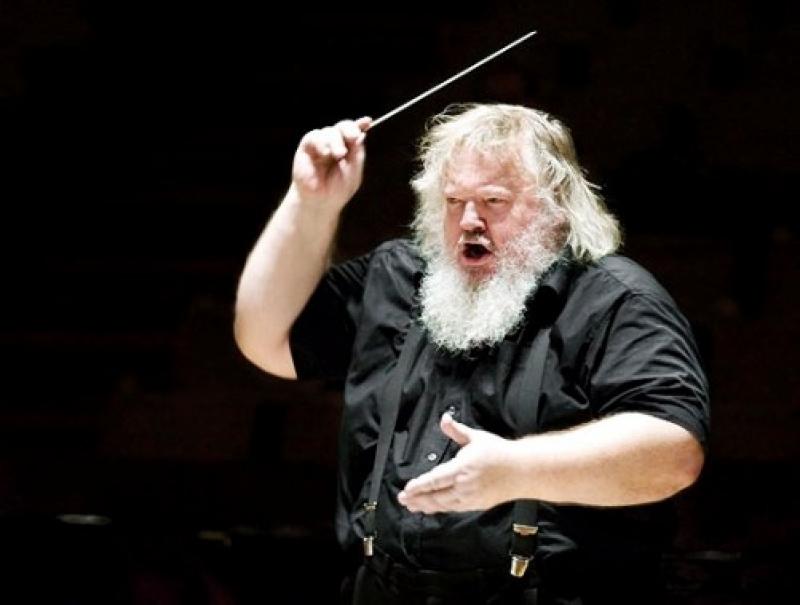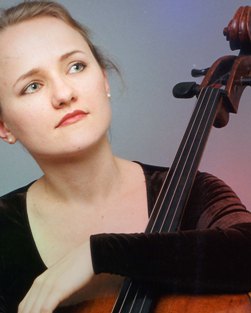London Schools Symphony Orchestra, Segerstam, Barbican Hall | reviews, news & interviews
London Schools Symphony Orchestra, Segerstam, Barbican Hall
London Schools Symphony Orchestra, Segerstam, Barbican Hall
Charismatic Finn raises the game of a fine youth orchestra in deep-vein Britten

With regional youth orchestras dropping from a thousand short-sighted, wholesale cuts - flagship Leicestershire the latest under threat - it should be enough just to celebrate 60 seasons of the LSSO, safe for now under the City of London's munificent wing. But last night was more than just another fun concert.
What I wasn't expecting was to find the ghost of Sibelius behind Britten's icy North Sea winds. Not the Sibelius of the cheery/bittersweet Karelia miniatures, where the composer's jovial compatriot even let his London young musicians do their own thing for a few bars in the Alla marcia while he turned to the audience, playing up to the Santa Claus image, and performed his version of a soft-shoe shuffle. No, Britten seems to have at the back of his mind the lean master of the Fourth Symphony and Tapiola, whose wood sprites flicker around the eerie, unquiet scherzo; throughout, there's the same sense of a desperate need to break free of the soul's dark night. The Symphony for Cello and Orchestra, to give it the full name, is a tough, exposed work for youth to handle, with huge gaps in the scoring to let the cellist breathe, however painfully. The centre certainly held here. LSSO's woodwind captured the elusive mood of their wraith-like writing and Segerstam's firm underlying rhythmic sense, apparent from the first bars of Berlioz's Roman Carnival Overture, was matched by that of his quietly remarkable cellist daughter Pia (pictured below by Kira Glusckoff).
 Very well, so it's not a sound that tears at the soul from the first note like that of the dedicatee, Rostropovich - whose is? - honoured by Britten with a starkly uningratiating monument to set alongside Prokofiev's Symphony Concerto and Shostakovich's Second. But Segerstam fille - a slender Mountain King's Daughter, focused inwardly on her playing rather than giving out to her younger colleagues - projects a more tightly focused golden tone that never let go of Britten's tortured rhetoric. There are still textures here that anyone writing a new work today would kill for, above all the return of contrabassoon, tuba and double bass writhing with woodwind unisons above boring a memorable oscillation into the brain while the cellist strums guitar-like pizzicati to its uneasy rest. The work's final, almost cinematic liberation always comes as a surprise: another case, perhaps, of Billy Budd's repressed sea captain catching sight of "a far-shining sail". And it is indeed a true ensemble piece which shares its bold ideas; outstanding contributions came with gun-shot timpanism from Jack McNeill-Adams and a skewed sea-shanty trumpet solo boldly taken by Louis Barclay.
Very well, so it's not a sound that tears at the soul from the first note like that of the dedicatee, Rostropovich - whose is? - honoured by Britten with a starkly uningratiating monument to set alongside Prokofiev's Symphony Concerto and Shostakovich's Second. But Segerstam fille - a slender Mountain King's Daughter, focused inwardly on her playing rather than giving out to her younger colleagues - projects a more tightly focused golden tone that never let go of Britten's tortured rhetoric. There are still textures here that anyone writing a new work today would kill for, above all the return of contrabassoon, tuba and double bass writhing with woodwind unisons above boring a memorable oscillation into the brain while the cellist strums guitar-like pizzicati to its uneasy rest. The work's final, almost cinematic liberation always comes as a surprise: another case, perhaps, of Billy Budd's repressed sea captain catching sight of "a far-shining sail". And it is indeed a true ensemble piece which shares its bold ideas; outstanding contributions came with gun-shot timpanism from Jack McNeill-Adams and a skewed sea-shanty trumpet solo boldly taken by Louis Barclay.
The rest of the programme was more of a holiday, though Segerstam showed a true Finn's austerity in the abrupt pauses between the surprisingly busy string textures of Karelia's Ballade. He wouldn't let Berlioz's carnival coruscate: this was more a case of Kaurismäki's laconic Finns abroad - Leningrad Cowboys do Piazza Navona, perhaps, gaping with beers in hand at the kerfuffle around them - but what it did boast was exemplary tempo control and fabulous crescendi. Which takes us all the way from the single-note swells of horn and clarinet to the slow burn of ghost cohorts on the Appian way in Respighi's Pines of Rome.
That's always a good showcase for large youth-orchestra forces, and duly unfurled with inscaped splendour as the ancient Roman buccine fanfared from the Barbican Hall's grand circle; but here, too, Segerstam brought his own sound to bear in the unique depths of string tone that turned the auditorium, somehow, into a resonating cathedral for the central rites of catacombs and Janiculum. And he took a typical liberty with the swelling chant of underground Christians - starting loud with unforgettable contrabassoon edge, rising to apocalyptic. Yes, the Segerstam crescendo is unique, as is the man himself, who ambled out to the front stalls at the end to encourage a standing ovation for his fabulous young players.
- Find out more about the Centre for Young Musicians where the LSSO is based
- See what's on at the Barbican Centre
 Find Leif Segerstam on Amazon
Find Leif Segerstam on Amazon
Watch Segerstam conduct the Gothenburg Symphony Orchestra in the Alla marcia from Sibelius's Karelia Suite
Share this article
The future of Arts Journalism
You can stop theartsdesk.com closing!
We urgently need financing to survive. Our fundraising drive has thus far raised £49,000 but we need to reach £100,000 or we will be forced to close. Please contribute here: https://gofund.me/c3f6033d
And if you can forward this information to anyone who might assist, we’d be grateful.

Subscribe to theartsdesk.com
Thank you for continuing to read our work on theartsdesk.com. For unlimited access to every article in its entirety, including our archive of more than 15,000 pieces, we're asking for £5 per month or £40 per year. We feel it's a very good deal, and hope you do too.
To take a subscription now simply click here.
And if you're looking for that extra gift for a friend or family member, why not treat them to a theartsdesk.com gift subscription?
more Classical music
 Bizet in 150th anniversary year: rich and rare French offerings from Palazzetto Bru Zane
Specialists in French romantic music unveil a treasure trove both live and on disc
Bizet in 150th anniversary year: rich and rare French offerings from Palazzetto Bru Zane
Specialists in French romantic music unveil a treasure trove both live and on disc
 Scottish Chamber Orchestra, Ibragimova, Queen’s Hall, Edinburgh review - rarities, novelties and drumrolls
A pity the SCO didn't pick a better showcase for a shining guest artist
Scottish Chamber Orchestra, Ibragimova, Queen’s Hall, Edinburgh review - rarities, novelties and drumrolls
A pity the SCO didn't pick a better showcase for a shining guest artist
 Kilsby, Parkes, Sinfonia of London, Wilson, Barbican review - string things zing and sing in expert hands
British masterpieces for strings plus other-worldly tenor and horn - and a muscular rarity
Kilsby, Parkes, Sinfonia of London, Wilson, Barbican review - string things zing and sing in expert hands
British masterpieces for strings plus other-worldly tenor and horn - and a muscular rarity
 From Historical to Hip-Hop, Classically Black Music Festival, Kings Place review - a cluster of impressive stars for the future
From quasi-Mozartian elegance to the gritty humour of a kitchen inspection
From Historical to Hip-Hop, Classically Black Music Festival, Kings Place review - a cluster of impressive stars for the future
From quasi-Mozartian elegance to the gritty humour of a kitchen inspection
 Shibe, LSO, Adès, Barbican review - gaudy and glorious new music alongside serene Sibelius
Adès’s passion makes persuasive case for the music he loves, both new and old
Shibe, LSO, Adès, Barbican review - gaudy and glorious new music alongside serene Sibelius
Adès’s passion makes persuasive case for the music he loves, both new and old
 Anja Mittermüller, Richard Fu, Wigmore Hall review - a glorious hall debut
The Austrian mezzo shines - at the age of 22
Anja Mittermüller, Richard Fu, Wigmore Hall review - a glorious hall debut
The Austrian mezzo shines - at the age of 22
 First Person: clarinettist Oliver Pashley on the new horizons of The Hermes Experiment's latest album
Compositions by members of this unusual quartet feature for the first time
First Person: clarinettist Oliver Pashley on the new horizons of The Hermes Experiment's latest album
Compositions by members of this unusual quartet feature for the first time
 Gesualdo Passione, Les Arts Florissants, Amala Dior Company, Barbican review - inspired collaboration excavates the music's humanity
At times it was like watching an anarchic religious procession
Gesualdo Passione, Les Arts Florissants, Amala Dior Company, Barbican review - inspired collaboration excavates the music's humanity
At times it was like watching an anarchic religious procession
 Classical CDs: Camels, concrete and cabaret
An influential American composer's 90th birthday box, plus British piano concertos and a father-and-son duo
Classical CDs: Camels, concrete and cabaret
An influential American composer's 90th birthday box, plus British piano concertos and a father-and-son duo
 Cockerham, Manchester Camerata, Sheen, Martin Harris Centre, Manchester review - re-enacting the dawn of modernism
Two UK premieres added to three miniatures from a seminal event of January 1914
Cockerham, Manchester Camerata, Sheen, Martin Harris Centre, Manchester review - re-enacting the dawn of modernism
Two UK premieres added to three miniatures from a seminal event of January 1914
 Kempf, Brno Philharmonic, Davies, Bridgewater Hall, Manchester review - European tradition meets American jazz
Bouncing Czechs enjoy their Gershwin and Brubeck alongside Janáček and Dvořák
Kempf, Brno Philharmonic, Davies, Bridgewater Hall, Manchester review - European tradition meets American jazz
Bouncing Czechs enjoy their Gershwin and Brubeck alongside Janáček and Dvořák
 Solomon, OAE, Butt, QEH review - daft Biblical whitewashing with great choruses
Even a top soprano and mezzo can’t make this Handel paean wholly convincing
Solomon, OAE, Butt, QEH review - daft Biblical whitewashing with great choruses
Even a top soprano and mezzo can’t make this Handel paean wholly convincing

Add comment